Your food preservation pit's depth should align with your local frost line and climate conditions, typically ranging from 4 to 10 feet deep. You'll need deeper pits (8-10 feet) in warmer regions to maintain cool temperatures, while colder areas can use shallower pits (4-6 feet). Your soil type also matters – dig deeper in sandy soil (around 6 feet) and shallower in clay soil (3-5 feet). Make sure you're digging below your local frost line to prevent freezing cycles, and always check your groundwater levels first. Understanding these key factors will help you create the perfect storage solution for your specific location.
Understanding Frost Line Basics
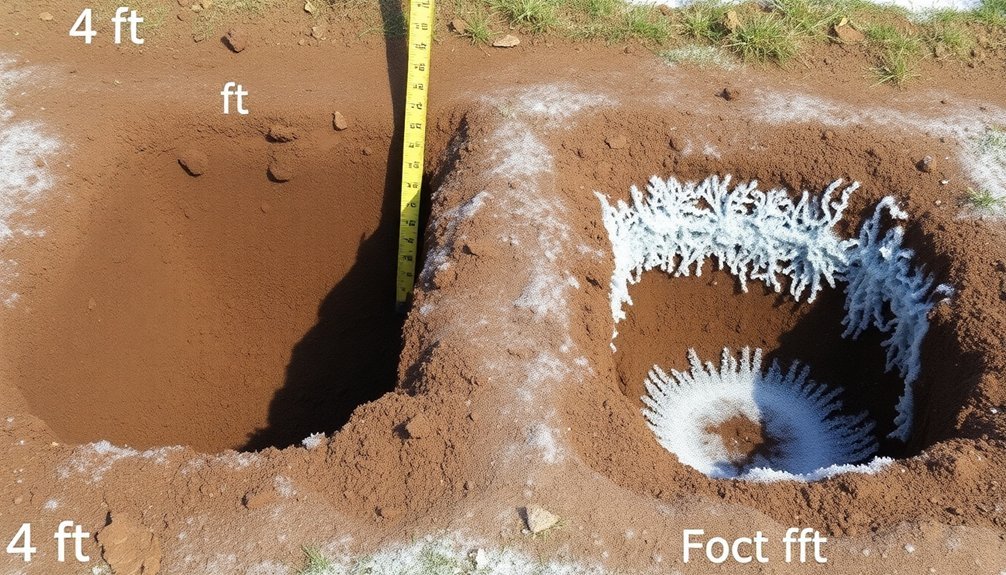
When planning a food preservation pit, understanding the frost line is essential for long-term storage success. The frost line represents the depth where groundwater in soil freezes, and it's a critical factor in determining how deep you'll need to dig your storage pit to prevent your preserved foods from freezing or experiencing damaging temperature fluctuations.
You'll find that frost line depth varies greatly based on your location. In the contiguous United States, the frost line can reach up to 8 feet deep in some areas. If you're closer to the poles, you'll need to dig deeper than if you're in a warmer climate. For example, you'll encounter much deeper frost lines in Minnesota compared to Florida.
Several factors affect your local frost line, including climate conditions, soil properties, and even nearby heat sources like buildings or asphalt.
Don't confuse the frost line with permafrost, which is permanently frozen ground found in northern regions. To determine your area's frost line, you can consult local frost depth maps or speak with building inspectors who'll know the specific requirements for your region.
Consider that snow cover can act as an insulator, potentially reducing the depth you'll need to dig, while local soil conditions and temperature patterns may require adjustments to your pit's depth.
Climate Impact on Pit Depth
When planning your food preservation pit depth, you'll need to account for how climate change affects regional temperature patterns and frost line variations.
Your pit must extend below the frost line to protect stored foods from freezing and thawing cycles, which can vary greatly as weather patterns become more extreme.
You'll want to monitor your area's changing frost depths and adjust your pit specifications accordingly, following local guidelines that may need updating as climate patterns shift. Extreme temperatures and unpredictable weather events are increasingly affecting growing and storage seasons, making proper pit depth crucial for food preservation.
Regional Temperature Variations
Regional temperature variations substantially impact the required depth of food preservation pits across different climate zones.
You'll need to evaluate your specific location's temperature patterns when determining the ideal pit depth, as both seasonal and daily fluctuations affect food preservation effectiveness.
In warmer regions, you'll want to dig deeper pits to maintain cooler temperatures, while in higher-latitude areas, you might require shallower depths due to naturally cooler soil conditions.
- Lower-latitude regions often require pits 8-10 feet deep to counteract higher ambient temperatures
- Higher-latitude locations may only need 4-6 feet of depth due to cooler ground temperatures
- Dryland areas need additional depth assessments to protect against extreme temperature swings
- Mountain regions can utilize shallower pits due to naturally cooler temperatures
- Coastal areas require medium-depth pits with additional moisture protection
Your pit's depth should account for local climate projections, as rising temperatures may necessitate deeper excavation. Extreme weather events are becoming more frequent, making proper pit depth planning increasingly critical for maintaining food safety.
If you're in an area experiencing significant temperature increases, think about adding an extra foot of depth to accommodate future climate changes.
Remember that proper depth helps maintain consistent temperatures, essential for preserving food quality and preventing pathogen growth.
Frost Protection Guidelines
Proper frost protection greatly influences the longevity of your food storage pit's effectiveness. You'll need to evaluate both passive and active methods to guarantee your stored food remains safe from freezing temperatures. Start by selecting a site that's naturally protected from harsh winds and extreme temperature fluctuations.
To protect against frost damage, you'll want to implement multiple layers of defense. Line your pit with insulating materials like leaves or bark, and wrap your food items in moisture-resistant containers before placing them inside.
You should also cover the pit with a waterproof tarp and additional insulation layers to maintain stable temperatures. Climate change impacts require you to adjust your frost protection strategy. You might need to dig deeper pits as soil temperatures rise, and you'll want to add extra waterproofing due to changing precipitation patterns.
Monitor your pit regularly for temperature changes and moisture buildup. Don't forget to maintain proper ventilation while keeping the pit sealed against frost. Regular inspections will help you identify and address any issues before they compromise your food storage.
If you notice signs of dampness or temperature fluctuations, add more insulation or adjust your protective measures accordingly.
Soil Types and Digging Depth
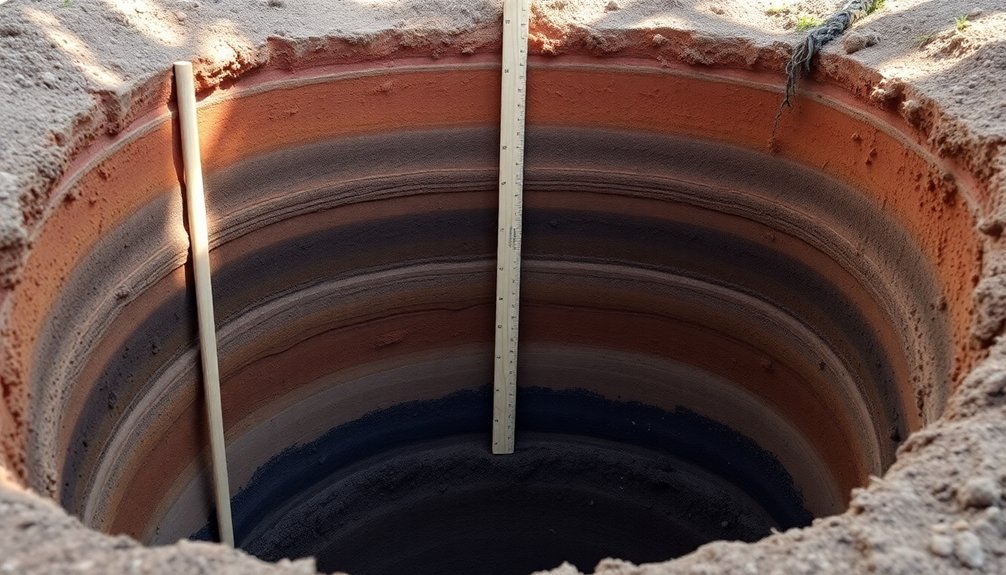
When planning your food preservation pit, you'll need to dig deeper in sandy soil (around 2 metres) compared to clay soil (1-1.5 metres) due to sandy soil's poorer insulation properties.
You'll want to check for rock layers before starting, as these can affect both your digging depth and the pit's drainage capabilities.
In clay-heavy soils, consider adding a layer of gravel at the bottom to improve drainage, while in sandy soils, you might need to reinforce the walls to prevent collapse.
Clay Soil Depth Requirements
Clay soil depth requirements vary considerably based on moisture management and crack prevention concerns. While traditional wisdom suggested deeper pits of 1.5 meters, modern practices often favor shallower depths around 0.5 meters to minimize wall exposure to cracks and maintain drier conditions.
You'll find that shallower, wider pits help you better control moisture diffusion through the soil, which is vital for preventing grain deterioration.
Key aspects to take into account for clay soil pit depth:
- Shallower pits (0.5m) reduce crack exposure and maintain better moisture control than deeper alternatives
- Thick chaff lining on bottom and sides creates an effective moisture barrier
- Clay's high water-holding capacity requires careful depth planning to prevent excess moisture
- Surface crack coverage helps minimize rainwater seepage during wet seasons
- Wider, shallower designs provide better structural integrity in cracking clay soils
When you're digging your pit, work with slightly moist soil for easier evaluation and excavation.
Remember that proper chaff lining is essential regardless of depth – you'll need substantial amounts to create an effective moisture barrier.
If you're dealing with heavily cracking clay, prioritize crack prevention strategies alongside your depth considerations.
Sandy Soil Digging Tips
Unlike clay soil's moisture concerns, sandy soil presents unique challenges that demand specific digging techniques and equipment choices. When digging your food preservation pit in sandy soil, you'll need to focus on stability and precision to prevent cave-ins and guarantee successful excavation.
Select equipment with broad, high-flotation tracks or deep-treaded tires to maintain stability. You'll want to dig slowly and remove material in small increments, as aggressive digging can cause soil collapse. Keep your equipment well-lubricated and clean to counter sand's abrasive nature.
| Equipment Type | Best Features | Maintenance Needs |
|---|---|---|
| Excavator | Wide tracks, curved bucket | Daily track cleaning |
| Skid Steer | Deep tread tires | Regular tire pressure checks |
| Buckets | Wide teeth, curved edges | Frequent lubrication |
| Trench Shields | Metal construction | Inspection before use |
| Support Systems | Adjustable bracing | Regular stability checks |
Before digging, conduct soil tests to determine the pit's required support structure. You'll need to use trench shields and proper shoring instead of relying on sloping techniques. Remember to maintain clean equipment and inspect the excavation site regularly to guarantee ongoing stability and safety.
Rock Layer Considerations
The depth of your food preservation pit heavily depends on both local soil composition and the strategic placement of rock layers.
When layering rocks in your pit, you'll need to carefully consider their weight, heat retention properties, and ability to create proper sealing. The rocks you select should be clean and appropriately sized to maintain pressure on your stored food while establishing anaerobic conditions essential for preservation.
Here's what you need to know about rock layering for your preservation pit:
- Use volcanic or dense stones for ideal heat retention during fermentation processes
- Place heavier rocks on top to create adequate pressure and seal off the contents
- Position coral rocks (if available) strategically, as they're excellent for maintaining consistent temperatures
- Create a proper seal by arranging rocks in overlapping patterns around the pit's edges
- Layer smaller rocks first, followed by progressively larger ones for stable weight distribution
You'll want to verify your rock layers work in harmony with your soil type.
If you're working with limestone-based soils, you can use fewer rocks for pH stability, while sandy soils might require more extensive rock layering for proper insulation and moisture control.
Measuring Ground Water Levels
Several reliable methods exist for measuring groundwater levels, each offering distinct advantages and limitations. You'll find that piezometers provide the most accurate measurements compared to standard groundwater standpipes, while observation wells offer standardized results but require careful consideration of location and depth.
When measuring groundwater for your food preservation pit, you'll need to conduct extended observations. It's essential to take 24-hour water level readings, as shorter durations won't give you reliable data. Don't rely on brief 40-minute observations, as they can miss important fluctuations in the water table.
You can use various measurement techniques, from simple tape measurements in shallow wells to more sophisticated geophysical methods that use electromagnetic signals. If you're dealing with complex soil conditions, you might need multiple bore holes to detect perched water tables.
Remember that measurement errors can reach several decimeters, especially in areas with limited data. For your food preservation pit's safety, you'll want to use at least two different measurement methods to cross-verify your findings.
Consider hiring professionals to conduct groundwater pumping tests if you're in an area with uncertain water conditions.
Regional Depth Requirements
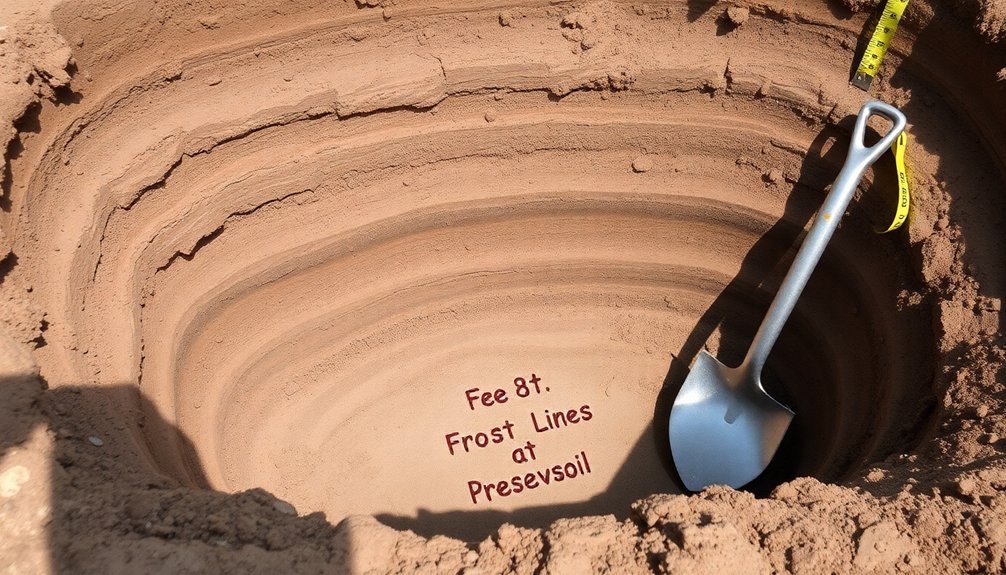
Regional depth requirements for food preservation pits vary considerably based on your local climate and soil conditions. If you're in an area with harsh winters, you'll need to dig below the frost line to prevent freezing, while in hot, dry regions, a depth of 1-2 meters is typically sufficient to maintain cool temperatures. You'll want to adjust your pit's depth based on your specific geographical location and local weather patterns.
- Dig 10 feet (3 meters) deep for maximum temperature stability in root cellars.
- Stay within 1-2 meters depth in dry regions to keep vegetables cool and dry.
- Reduce depth in areas with high groundwater to prevent seepage.
- Adjust depth in mountainous regions based on terrain and slope.
- Consider shallower pits in rocky soil areas due to digging difficulties.
When determining your pit's depth, you'll need to account for several local factors. In coastal areas, watch for saltwater intrusion and moisture levels.
If you're in an urban setting, check local building codes before digging. Avoid locations near large trees, as roots can interfere with your pit's structure.
Remember that proper drainage is vital, especially in regions with significant rainfall.
Optimal Storage Space Calculations
Calculating ideal storage space for your food preservation pit starts with three key measurements: volume requirements, insulation layers, and access space.
You'll need to determine how many vegetables you plan to store and consider their density when packed together. Remember to account for future storage needs if you're expecting your preservation requirements to grow.
When calculating the total volume, factor in the essential insulation layers. You'll need space for a base layer of sand, straw, or leaves, plus room for the protective covering of banana leaves and the 25-50cm soil layer on top.
Don't forget to include space for storage materials like sacks or cloth bags, which help prevent disease spread and make retrieval easier.
Your calculations should also incorporate sufficient access space. You'll want enough room to reach stored items without disturbing the rest of your preservation setup.
Consider creating wider sections at the top of your pit for easier access. To maximize efficiency, plan how you'll arrange your vegetables – keeping frequently accessed items near the top and longer-term storage items at the bottom.
This strategic organization helps maintain the pit's temperature stability while making retrieval more practical.
Drainage and Depth Relationship
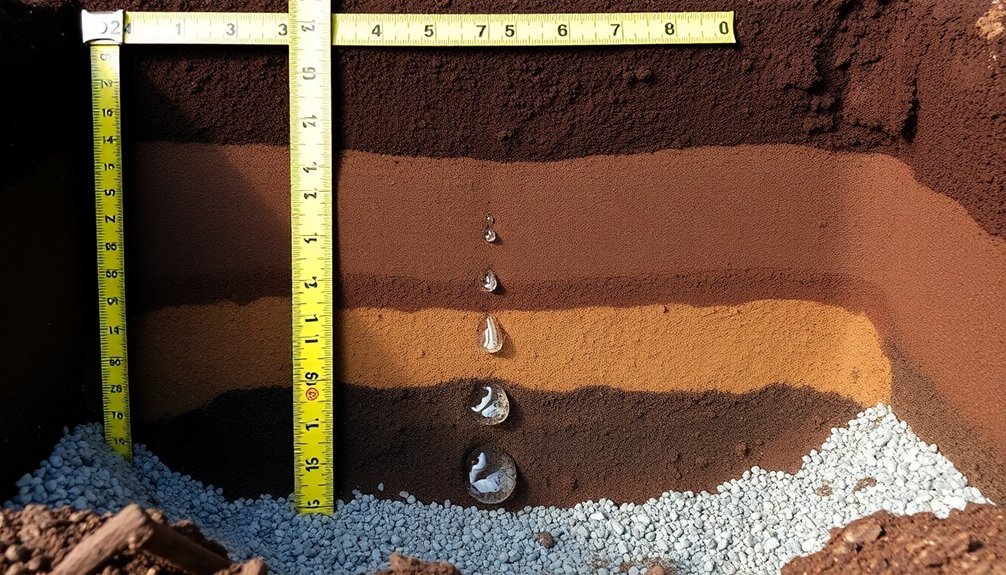
The depth of your food preservation pit directly affects its drainage capabilities, which builds upon the storage calculations we just covered. You'll need to take into account both ideal depth for food storage and proper drainage to prevent water damage to your preserved goods.
While traditional drainage systems are typically placed 3-4 feet deep, your food pit requires special attention to prevent waterlogging and guarantee long-term preservation.
- Your pit's depth should account for local soil type – clay soils need deeper drainage solutions than sandy soils.
- You'll want at least 3 feet of effective drainage area above your water table to protect stored foods.
- Think about installing a filtration system to prevent sediments from clogging your drainage.
- Match your drainage intensity to the value and sensitivity of the foods you're storing.
- Include subsoil loosening techniques around your pit to improve water movement.
The relationship between depth and drainage isn't just about digging deeper. You'll need to balance factors like soil permeability, water table levels, and local rainfall patterns.
Installing proper drainage at the right depth helps maintain field capacity while preventing over-saturation that could compromise your stored foods. Remember, effective drainage is vital for preventing moisture-related spoilage in your preservation pit.
Frequently Asked Questions
How Do I Prevent Animals From Accessing My Food Storage Pit?
You'll need to build a secure well box with a tight-fitting hatch, add physical barriers like straw layers, use sacks for storage, maintain regular inspections, and create drainage trenches to keep animals away.
Can I Store Different Vegetables Together at Varying Pit Levels?
You shouldn't store different vegetables together, even at varying pit levels. They'll compete for space and affect each other through gas exchange. Instead, create separate compartments or use multiple pits for different vegetable types.
What Materials Work Best for Lining Corners of Storage Pits?
You'll get the best results using straw or dried leaves to line your pit's corners. Add a layer of sand for drainage, and consider banana leaves for moisture control if they're available locally.
How Often Should I Rotate Food Items in Different Pit Sections?
You'll need to rotate root vegetables monthly, solid vegetables every 2-3 weeks, and dried foods annually. Check regularly for rot and remove spoiled items immediately. Follow the FIFO method for all stored foods.
Should I Install Backup Ventilation Systems for Deeper Storage Pits?
You don't need backup ventilation for food preservation pits. They rely on natural insulation and proper covering. Adding ventilation systems can disrupt temperature balance and create unwanted moisture problems in your stored food.
In Summary
You'll want to dig your food preservation pit at least 2-3 feet below your local frost line, while accounting for your specific soil type and groundwater levels. Don't forget to factor in your region's climate patterns and storage needs when determining the final depth. Remember to include proper drainage at the bottom of your pit to prevent water accumulation and food spoilage.

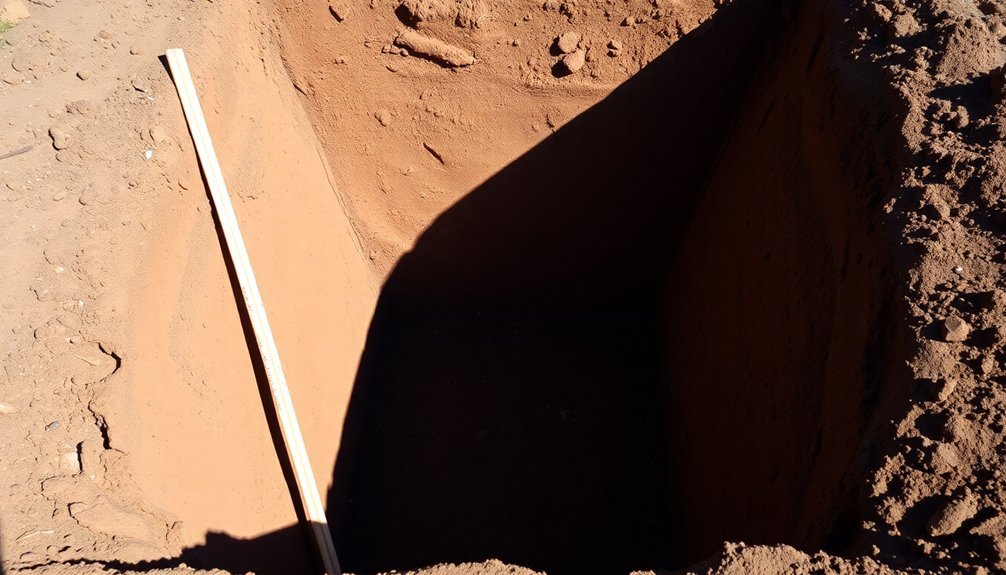



Leave a Reply